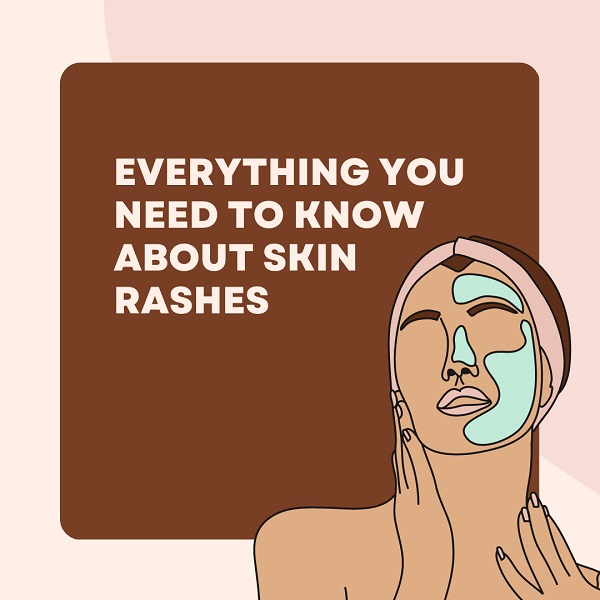Everything You Need to Know About Skin Rashes

A skin rash is a change in the color, texture, or appearance of the skin that can cause redness, itching, and bumpiness. Rashes can be caused by a wide variety of factors, including allergies, infections, and certain medical conditions. Some common causes of rashes include:
Also Read: –Mediterranean Diet for Heart Health- Meal Plan, Foods List, and Tips
- Allergies: Rashes can be caused by an allergic reaction to a substance, such as poison ivy, certain medications, or cosmetics.
- Infections: Rashes can be caused by viral, bacterial, or fungal infections, such as chickenpox, impetigo, or athlete’s foot.
- Medical conditions: Rashes can be a symptom of certain medical conditions, such as eczema, psoriasis, or lupus.
- Hormonal changes: Hormonal fluctuations in the body can cause rashes in certain areas such as pregnancy, menopause etc
- Environmental factors: Certain environmental factors, such as exposure to sunlight, heat, or cold, can cause rashes.
Rashes can vary in appearance, from small, red dots to large, raised welts. They can be itchy, painful, or even accompanied by other symptoms, such as fever or swollen lymph nodes. Different types of rashes require different types of treatment, so it’s important to see a doctor if you are experiencing a rash that is causing discomfort or concern. A healthcare professional will be able to diagnose the cause of the rash and recommend appropriate treatment.
A rash is a change in the skin that can cause redness, itching, and bumpiness. Rashes can be caused by a wide variety of factors, including allergies, infections, and certain medical conditions. Some common types of rashes include:
- Atopic dermatitis (eczema): a chronic, itchy rash that is often found on the face, arms, and legs.
- Contact dermatitis: a rash that occurs as a result of direct contact with an irritant or allergen, such as poison ivy or a cosmetic product.
- Psoriasis: a chronic, inflammatory skin condition that causes red, scaly patches on the skin.
- Hives (urticaria): raised, red, itchy welts that can appear on any part of the skin.
- Rosacea: a chronic skin condition that causes redness and visible blood vessels on the face.
- Shingles (Herpes Zoster) : A viral infection caused by the varicella-zoster virus (VZV) which results in a painful rash on the body.
How do I identify a rash?
Identifying a rash can be challenging because rashes can have many different appearances, and the symptoms and causes can vary widely. Here are some ways to identify a rash:
- Location: Pay attention to where the rash is located on your body. Some rashes are more likely to appear in certain areas, such as eczema on the inner crease of the elbows and knees, or hives on the face and neck.
- Appearance: Take note of the rash’s color, shape, and texture. A rash can be red, pink, or brown, and it can be flat or raised. It can have a smooth or rough texture.
- Size and shape: The rash can be small or large and it can have a consistent shape or can be irregular.
- Symptoms: Pay attention to any symptoms that you may be experiencing alongside the rash, such as itching, burning, or pain. Some rashes may also cause swelling or fluid-filled blisters.
- Duration: Note how long you have had the rash. Some rashes may come and go, while others may be more persistent.
- Triggers: pay attention to what triggers your rash, certain food, medication, environment, or temperature change.
Final Words
Eczema is a chronic, inflammatory skin condition characterized by dry, itchy skin that can become red and inflamed. Contact dermatitis is caused by contact with an allergen or irritant such as poison ivy or certain soaps, lotions, or cosmetics. Psoriasis is a chronic, inflammatory skin condition that causes red, scaly patches on the skin. Hives (urticaria) are raised, red, itchy welts that can appear on any part of the skin caused by an allergic reaction or a reaction to certain medications. Rosacea is a chronic skin condition that causes redness and visible blood vessels on the face.
Treatment for a skin rash will depend on the underlying cause. Over-the-counter creams and ointments, such as hydrocortisone cream or calamine lotion, can help relieve itching and inflammation. Moisturizers can also be helpful in keeping the skin hydrated and reducing itching. In more severe or persistent cases, a healthcare professional may prescribe stronger medications or recommend other treatments. It is important to work with a healthcare professional to find the best treatment plan for your specific rash.








